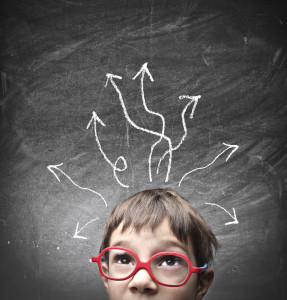Many parents (myself included) want their kids to listen. We want to make a request and hear something along the lines of, “Sure, Ok Mom/Dad. No problem.” Sounds blissful, doesn’t it? It’s certainly an attainable goal and there are many ways to help our kids want to cooperate (please see previous posts on the topic of cooperation). So what gets in the way? Why does it seem so hard to gain our kids cooperation?
In addition to it being a kids job to test limits and boundaries, the reality is that often, quite often, our agendas and our kids agendas simply don’t match up. They want one thing, we want another. Rather than see it for what it commonly is – a mismatch in itineraries, we may feel defeated, challenged, threatened etc. That’s when our self-talk kicks in – “Did he really just “disobey” me?” “How did I get such a “defiant” child?” “What’s WRONG with her?”
As discussed in a previous post, that inner chatter sets in motion all kinds of emotions as well as mistaken beliefs about why our child is behaving the way he is. We begin to feel out of control. And what is a natural reaction to feeling out of control? You guessed it, try to GAIN control. Often, this is when parents turn to punishment.
Parents I work with in my coaching practice come to me when what they have tried just isn’t working or has stopped working….the reward charts, the time-outs, the spanking, the yelling, nagging and lecturing, the removal of privileges and so on. These amazing parents want to know why – why their punishment isn’t working and they are eager to gain the insight into how they can create a more calm, less chaotic relationship and home environment.
To help parents understand why punishment doesn’t work, we often begin by discussing the brain science of it all. Thanks to the incredible field of neuroscience, including “whole-brain” experts such as Dan Siegel, MD and Tina Bryson, Ph.D, we have empirically based research that supports the answers to these very important questions. Here’s what we know:
The prefrontal cortex is the part of the brain responsible for impulse control, emotional regulation, self-awareness, logical reasoning, decision making, planning, along with other higher order functions. This part of the brain is not said to be fully developed until early adulthood. In fact, some have documented not until the age of 25! So, it’s no wonder that kids have a difficult time “controlling themselves,” as the part of their brain responsible for sound decision making and impulse control, for example, is still “under construction.”
Punishment, by nature, involves blame, shame and/or pain. Merriam-Webster Dictionary defines punishment as, “suffering, pain or loss that serves as retribution.”
When a child experiences punishment, in the form of yelling, threats, “consequences,” and the like, the brain perceives these behaviors as a threat and goes into survival mode, otherwise know as fight, flight or freeze. Behaviorally, this often takes the form of tantrums or back talk, running away or eyeball rolling, retreat or withdrawal, to name a few. When the brain is in this mode, no true learning (of appropriate behavior) can take place. The child’s defenses are activated and the brain becomes enraged vs. engaged.
Punishment may have the illusion of working, as it may stop the (mis)behavior in the moment, but it’s at a cost (the relationship often suffers and the sense of trust is shaken) and does not get to the core of why the behavior is happening in the first place. As a result, we find that children may “listen” more out of fear, rather than out of true respect for and connection to their parents. Furthermore, the behaviors and the negative cycle continues.
Knowing the brain science behind why punishment doesn’t work affords us the opportunity to try a different approach – an approach which is focused more on connecting instead of controlling. In Positive Discipline, we refer to this as “Connection Before Correction.” When misbehavior happens, focusing on connection is one way in which we help our child’s brain move from a reactive state to one which is more open to and accepting of the loving guidance we have and choose to offer. When we connect, through empathy, acceptance of all emotions (not just the positive ones) and mindful presence, our child can be guided in developing the life skills he needs to learn from his mistakes and choose more appropriate behavior in the future. As Jane Nelsen, author of Positive Discipline says, “Kids don’t need to suffer in order to learn.”
Choose connection, which builds trust and a sense of security. The “listening” will follow.
It starts with us.
All the best,
Debbie




